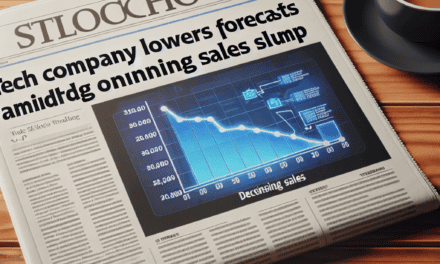“Market Momentum: Tesla’s 11% Surge Sparks Futures Rebound After Selloff”
Introduction
Following a significant market selloff, futures rebounded as investor sentiment improved, driven in part by a notable surge in Tesla’s stock, which climbed 11%. This upswing in Tesla’s shares came after the company reported stronger-than-expected earnings and unveiled promising developments in its product line, boosting confidence among investors. The rebound in futures indicates a potential stabilization in the market, as traders reassess their positions and respond to positive corporate news. Tesla’s performance, a key indicator of tech sector health, played a crucial role in lifting market spirits, suggesting a renewed appetite for risk among investors.
Tesla’s Impact on Futures Rebound: Analyzing the 11% Surge
In the wake of a recent market selloff, futures have shown a notable rebound, largely driven by a significant surge in Tesla’s stock price. The electric vehicle giant’s shares soared by an impressive 11%, injecting a renewed sense of optimism into the market. This development has not only captured the attention of investors but also underscored the influential role that major corporations like Tesla play in shaping market dynamics. As we delve into the factors contributing to this rebound, it becomes evident that Tesla’s performance is a key catalyst in the broader market recovery.
To begin with, Tesla’s remarkable 11% surge can be attributed to a combination of positive news and investor sentiment. The company recently reported better-than-expected quarterly earnings, which exceeded analysts’ forecasts and demonstrated robust growth in both revenue and profit margins. This financial performance has reinforced investor confidence in Tesla’s ability to navigate challenges and capitalize on opportunities within the competitive electric vehicle market. Moreover, Tesla’s ongoing expansion into international markets and its commitment to innovation have further bolstered its appeal to investors seeking growth-oriented opportunities.
In addition to its strong financial results, Tesla’s strategic initiatives have played a crucial role in driving its stock price higher. The company’s advancements in battery technology and autonomous driving capabilities have positioned it as a leader in the automotive industry. These technological innovations not only enhance Tesla’s competitive edge but also contribute to the broader adoption of electric vehicles, which is a key factor in the global transition towards sustainable transportation. As a result, investors are increasingly viewing Tesla as a pivotal player in the future of mobility, further fueling its stock price appreciation.
Furthermore, Tesla’s influence extends beyond its own stock performance, as it has a significant impact on market sentiment and investor behavior. The company’s success serves as a barometer for the health of the technology and automotive sectors, which are integral components of the broader market. When Tesla experiences a surge, it often leads to a ripple effect, boosting confidence in related industries and encouraging investors to re-enter the market. This phenomenon was evident in the recent futures rebound, as Tesla’s 11% surge helped to alleviate concerns stemming from the prior selloff and prompted a renewed interest in equities.
Moreover, the broader market context also plays a role in understanding the significance of Tesla’s impact on futures. The recent selloff was driven by a confluence of factors, including macroeconomic uncertainties, geopolitical tensions, and concerns over inflation. In such an environment, positive developments from influential companies like Tesla can serve as a counterbalance, providing a sense of stability and optimism. As investors digest these dynamics, the interplay between individual corporate performance and broader market trends becomes increasingly apparent.
In conclusion, Tesla’s 11% surge has been instrumental in the recent rebound of futures following a market selloff. The company’s strong financial performance, strategic initiatives, and technological advancements have not only propelled its stock price but also influenced market sentiment and investor behavior. As Tesla continues to shape the future of the automotive industry, its impact on the broader market is likely to remain significant. This underscores the importance of closely monitoring the performance of major corporations, as their successes and challenges can have far-reaching implications for the financial landscape.
Market Dynamics: How Tesla’s Performance Influences Futures
In the ever-evolving landscape of financial markets, the interplay between individual stock performances and broader market indices often reveals intricate dynamics. Recently, this relationship was exemplified as futures rebounded following a significant selloff, driven in part by a remarkable 11% surge in Tesla’s stock. Understanding how Tesla’s performance influences futures requires a closer examination of market sentiment, investor behavior, and the broader economic context.
To begin with, Tesla’s influence on market dynamics is substantial, given its status as a major player in the automotive and technology sectors. As a component of major indices such as the S&P 500 and the Nasdaq-100, Tesla’s stock movements can have a pronounced impact on these indices, which in turn affects futures contracts linked to them. When Tesla experiences a significant price increase, as seen in its recent 11% surge, it can buoy investor sentiment and contribute to a more optimistic outlook for the market as a whole.
Moreover, Tesla’s performance often serves as a barometer for investor confidence in the technology and innovation sectors. The company’s ability to consistently deliver strong financial results, coupled with its ambitious growth plans, tends to attract considerable attention from both institutional and retail investors. This heightened interest can lead to increased trading volumes and volatility, which are key factors in the movement of futures markets. As investors react to Tesla’s positive performance, they may adjust their positions in futures contracts, leading to a rebound following a selloff.
In addition to its direct impact on indices, Tesla’s performance can also influence market sentiment through its role as a symbol of broader economic trends. For instance, Tesla’s success is often seen as indicative of the growing importance of sustainable energy and electric vehicles in the global economy. As such, a surge in Tesla’s stock price can be interpreted as a sign of confidence in these emerging sectors, prompting investors to reassess their outlook on related industries and, by extension, the overall market.
Furthermore, the recent rebound in futures following Tesla’s surge highlights the interconnectedness of global financial markets. In an era where information travels rapidly and market participants are increasingly interconnected, developments in one region or sector can have far-reaching implications. Tesla’s performance, therefore, not only affects U.S. markets but also has the potential to influence investor sentiment and futures trading in other parts of the world.
It is also important to consider the role of macroeconomic factors in shaping market dynamics. While Tesla’s surge undoubtedly played a role in the futures rebound, broader economic indicators such as interest rates, inflation, and geopolitical developments also contribute to market movements. Investors must weigh these factors alongside individual stock performances to form a comprehensive view of the market landscape.
In conclusion, the recent rebound in futures following a selloff, driven by Tesla’s impressive 11% surge, underscores the complex interplay between individual stock performances and broader market indices. Tesla’s influence extends beyond its direct impact on indices, serving as a barometer for investor confidence in technology and innovation sectors and reflecting broader economic trends. As global financial markets continue to evolve, understanding these dynamics will remain crucial for investors seeking to navigate the complexities of market behavior.
Investor Sentiment: The Role of Tesla in Market Recovery
Investor sentiment plays a crucial role in the dynamics of financial markets, often dictating the ebb and flow of stock prices. Recently, the market experienced a notable rebound following a significant selloff, with Tesla emerging as a key player in this recovery. The electric vehicle giant’s shares surged by an impressive 11%, providing a much-needed boost to investor confidence and contributing to the broader market’s upward trajectory. This development underscores the influential role that individual companies, particularly those with substantial market capitalization and innovative prowess, can have on overall market sentiment.
The recent selloff had left investors wary, with concerns about economic indicators and geopolitical tensions weighing heavily on market performance. However, the rebound, led in part by Tesla’s remarkable surge, highlights the resilience of the market and the potential for rapid recovery when positive catalysts emerge. Tesla’s performance can be attributed to several factors, including strong quarterly earnings, optimistic forward guidance, and continued advancements in technology and production capabilities. These elements combined to create a favorable outlook for the company, which in turn, instilled confidence among investors.
Moreover, Tesla’s influence extends beyond its own stock performance. As a leader in the electric vehicle industry, Tesla’s success is often seen as a barometer for the sector’s health and future prospects. The company’s ability to consistently innovate and expand its market share has set a benchmark for other players in the industry, thereby impacting investor sentiment across the board. Consequently, Tesla’s surge not only lifted its own stock but also had a ripple effect on related sectors, contributing to the overall market rebound.
In addition to Tesla’s individual performance, broader market dynamics also played a role in the recovery. The rebound was supported by a combination of factors, including easing inflationary pressures, positive economic data, and a more accommodative stance from central banks. These elements helped to alleviate some of the concerns that had previously driven the selloff, creating a more favorable environment for equities. As a result, investors were more willing to re-enter the market, further fueling the upward momentum.
Furthermore, the role of technology stocks in the market recovery cannot be overstated. As a major component of the tech sector, Tesla’s surge was emblematic of a broader trend that saw technology stocks leading the charge in the rebound. This sector’s inherent growth potential and its pivotal role in the modern economy make it a focal point for investors seeking opportunities in times of uncertainty. The strong performance of technology stocks, including Tesla, served to reinforce the notion that innovation and technological advancement remain key drivers of market growth.
In conclusion, the recent market rebound following a selloff highlights the significant impact that individual companies, such as Tesla, can have on investor sentiment and market dynamics. Tesla’s 11% surge not only bolstered its own stock but also contributed to a broader recovery, underscoring the interconnectedness of market forces. As investors continue to navigate an ever-evolving financial landscape, the role of influential companies and sectors will remain a critical factor in shaping market sentiment and driving future performance.
Futures Market Volatility: Lessons from Tesla’s Recent Surge

In the ever-evolving landscape of the financial markets, volatility remains a constant companion, often dictating the ebb and flow of investor sentiment. Recently, the futures market experienced a notable rebound following a significant selloff, with Tesla’s remarkable 11% surge playing a pivotal role in this recovery. This development offers valuable insights into the dynamics of market volatility and the factors that can influence investor behavior.
To begin with, the recent selloff in the futures market was driven by a confluence of factors, including macroeconomic uncertainties, geopolitical tensions, and fluctuating interest rates. These elements collectively contributed to a heightened sense of caution among investors, prompting a retreat from riskier assets. However, the subsequent rebound underscores the resilience of the market and the potential for rapid recovery when conditions improve.
Tesla’s impressive 11% surge serves as a case study in understanding how individual stocks can impact broader market trends. The electric vehicle giant’s performance was buoyed by a combination of strong quarterly earnings, positive forward guidance, and strategic initiatives that resonated well with investors. This surge not only lifted Tesla’s stock but also had a ripple effect across related sectors, contributing to the overall recovery in the futures market.
Moreover, Tesla’s ascent highlights the importance of innovation and adaptability in driving investor confidence. The company’s continued focus on expanding its product lineup, enhancing production capabilities, and exploring new markets has positioned it as a leader in the automotive industry. This strategic vision has not only bolstered Tesla’s market position but also instilled confidence in investors, who view the company as a bellwether for future growth.
In addition to Tesla’s individual performance, the broader market rebound can be attributed to a shift in investor sentiment. As fears surrounding macroeconomic challenges began to subside, market participants were more willing to re-engage with equities, particularly those with strong growth potential. This renewed optimism was further fueled by positive economic indicators, such as improved employment figures and robust consumer spending, which suggested a more favorable economic outlook.
Furthermore, the role of technology and innovation in shaping market dynamics cannot be overstated. Companies like Tesla, which are at the forefront of technological advancements, often serve as catalysts for market movements. Their ability to disrupt traditional industries and create new opportunities for growth attracts significant investor interest, thereby influencing market trends.
In conclusion, the recent rebound in the futures market, driven in part by Tesla’s 11% surge, offers several lessons for investors navigating the complexities of market volatility. It underscores the importance of staying informed about macroeconomic developments, understanding the impact of individual stocks on broader market trends, and recognizing the role of innovation in driving investor confidence. As the financial landscape continues to evolve, these insights will be invaluable for investors seeking to make informed decisions and capitalize on emerging opportunities. Ultimately, while market volatility presents challenges, it also offers opportunities for those who are prepared to adapt and respond to changing conditions.
Tesla’s Growth Trajectory: Implications for Future Market Trends
In the ever-evolving landscape of the stock market, the recent rebound in futures following a significant selloff has captured the attention of investors and analysts alike. Central to this resurgence is the remarkable performance of Tesla, whose shares surged by an impressive 11%. This development not only highlights Tesla’s robust growth trajectory but also offers insights into potential future market trends. As we delve into the implications of Tesla’s performance, it is essential to consider the broader context of the market and the factors contributing to this notable upswing.
Tesla’s recent surge can be attributed to a confluence of factors, including strong quarterly earnings, strategic advancements in technology, and an expanding global footprint. The company’s ability to consistently exceed market expectations has reinforced investor confidence, positioning Tesla as a bellwether for the electric vehicle (EV) industry. Moreover, Tesla’s innovative approach to sustainable energy solutions continues to resonate with a growing segment of environmentally conscious consumers, further solidifying its market position.
The implications of Tesla’s growth extend beyond the company itself, influencing broader market trends and investor sentiment. As Tesla continues to push the boundaries of technological innovation, it sets a benchmark for other companies within the EV sector. This competitive pressure is likely to spur further advancements and investments in clean energy technologies, driving the industry towards greater efficiency and sustainability. Consequently, investors are increasingly viewing Tesla’s success as indicative of the potential for growth within the broader clean energy market.
Furthermore, Tesla’s performance has significant ramifications for the stock market as a whole. The company’s ability to rebound strongly following a market selloff underscores the resilience of high-growth technology stocks. This resilience is particularly noteworthy in an environment characterized by economic uncertainty and fluctuating investor sentiment. As a result, Tesla’s success may encourage investors to reassess their portfolios, potentially leading to increased allocations towards technology and clean energy sectors.
In addition to its impact on market trends, Tesla’s growth trajectory also raises important considerations for regulatory and policy frameworks. As governments worldwide grapple with the challenges of climate change, the role of companies like Tesla in driving sustainable innovation becomes increasingly critical. Policymakers may look to Tesla’s success as a model for fostering innovation and investment in clean energy, potentially leading to more supportive regulatory environments for the industry.
Moreover, Tesla’s global expansion efforts highlight the importance of international markets in shaping the future of the EV industry. As the company continues to establish a presence in key regions such as Europe and Asia, it underscores the growing demand for sustainable transportation solutions worldwide. This international focus not only diversifies Tesla’s revenue streams but also positions the company to capitalize on emerging market opportunities.
In conclusion, the recent surge in Tesla’s stock price following a broader market selloff serves as a testament to the company’s growth trajectory and its implications for future market trends. As Tesla continues to innovate and expand its global footprint, it sets a precedent for the EV industry and influences investor sentiment across the stock market. The company’s success underscores the potential for growth within the clean energy sector and highlights the importance of supportive regulatory frameworks in fostering sustainable innovation. As such, Tesla’s performance offers valuable insights into the evolving dynamics of the stock market and the future of sustainable technology.
Sector Analysis: Electric Vehicles and Their Influence on Futures
In recent market developments, futures have experienced a notable rebound following a period of selloff, with a significant contribution from the electric vehicle sector, particularly Tesla, which has surged by an impressive 11%. This resurgence in futures is indicative of the broader market dynamics and the influential role that electric vehicle manufacturers, especially industry leaders like Tesla, play in shaping investor sentiment and market trajectories. The electric vehicle sector has been a focal point for investors, driven by increasing global emphasis on sustainable energy solutions and the transition away from fossil fuels. As governments worldwide implement stricter emissions regulations and offer incentives for electric vehicle adoption, companies within this sector are poised for substantial growth. Tesla, as a pioneer and dominant force in the electric vehicle market, often serves as a bellwether for the industry, and its performance can significantly impact market perceptions and futures trading.
The recent surge in Tesla’s stock can be attributed to several factors, including strong quarterly earnings, increased production capabilities, and strategic advancements in battery technology. These developments have not only bolstered investor confidence in Tesla’s long-term growth prospects but have also reinforced the viability and potential profitability of the electric vehicle sector as a whole. Consequently, this optimism has permeated the futures market, leading to a rebound as investors anticipate continued growth and innovation within the sector.
Moreover, the electric vehicle industry’s influence on futures is not limited to Tesla alone. Other key players, such as Rivian, Lucid Motors, and traditional automakers transitioning to electric models, contribute to the sector’s dynamism and potential. These companies are investing heavily in research and development, expanding production facilities, and forming strategic partnerships to enhance their competitive edge. As a result, the electric vehicle sector is becoming increasingly diversified, offering investors a range of opportunities to capitalize on the shift towards sustainable transportation.
In addition to company-specific developments, broader economic and geopolitical factors also play a crucial role in shaping the electric vehicle sector’s impact on futures. For instance, fluctuations in oil prices, trade policies, and technological advancements in renewable energy sources can influence investor sentiment and market trends. As the global economy continues to recover from the disruptions caused by the COVID-19 pandemic, the demand for electric vehicles is expected to rise, further solidifying the sector’s influence on futures.
Furthermore, the integration of electric vehicles into the broader energy ecosystem presents additional opportunities for growth and innovation. The development of charging infrastructure, advancements in battery storage technology, and the potential for vehicle-to-grid applications are areas that hold significant promise for the future. These innovations not only enhance the appeal of electric vehicles but also contribute to the overall stability and resilience of the energy grid, thereby attracting further investment and interest from market participants.
In conclusion, the recent rebound in futures following a selloff underscores the electric vehicle sector’s pivotal role in shaping market dynamics. Tesla’s impressive surge serves as a testament to the sector’s potential and the growing investor confidence in sustainable transportation solutions. As the industry continues to evolve and expand, its influence on futures is likely to persist, driven by technological advancements, regulatory support, and increasing consumer demand for environmentally friendly alternatives. Consequently, the electric vehicle sector remains a critical area of focus for investors seeking to navigate the complexities of the modern financial landscape.
Strategic Investing: Capitalizing on Tesla’s Market Movements
In the ever-evolving landscape of financial markets, strategic investing requires a keen eye for opportunities that arise from market fluctuations. Recently, futures rebounded following a significant selloff, with Tesla emerging as a standout performer, surging 11%. This development underscores the importance of understanding market dynamics and capitalizing on pivotal movements to optimize investment portfolios.
The recent selloff in the market was driven by a confluence of factors, including macroeconomic uncertainties and investor sentiment shifts. However, the subsequent rebound in futures indicates a renewed confidence among investors, suggesting that the market is poised for recovery. Amidst this backdrop, Tesla’s remarkable 11% surge has captured the attention of both seasoned investors and market analysts, highlighting the electric vehicle giant’s resilience and potential for growth.
Tesla’s performance can be attributed to several key factors that have bolstered investor confidence. Firstly, the company’s robust quarterly earnings report exceeded market expectations, showcasing its ability to navigate challenges and maintain profitability. This financial strength has reassured investors of Tesla’s long-term viability, prompting a surge in its stock price. Additionally, Tesla’s continued innovation in electric vehicle technology and expansion into new markets have positioned it as a leader in the automotive industry, further enhancing its appeal to investors seeking growth opportunities.
Moreover, Tesla’s strategic initiatives, such as its focus on sustainable energy solutions and advancements in autonomous driving technology, have resonated with environmentally conscious investors. As the global shift towards sustainability gains momentum, companies like Tesla that align with these values are likely to attract increased investment. This alignment not only enhances Tesla’s market position but also contributes to its stock’s upward trajectory.
In light of these developments, strategic investors are presented with a unique opportunity to capitalize on Tesla’s market movements. By analyzing the factors driving Tesla’s surge, investors can make informed decisions about their portfolios. For instance, those with a long-term investment horizon may consider increasing their exposure to Tesla, given its potential for sustained growth. Conversely, short-term traders might seek to leverage the stock’s volatility to generate quick returns.
Furthermore, the broader market rebound following the selloff suggests that investors are regaining confidence in the economic outlook. This renewed optimism presents an opportune moment for strategic investors to reassess their portfolios and identify sectors poised for recovery. By diversifying investments across industries that demonstrate resilience and growth potential, investors can mitigate risks and enhance returns.
In conclusion, the recent rebound in futures and Tesla’s impressive 11% surge underscore the dynamic nature of financial markets and the importance of strategic investing. By staying informed about market trends and understanding the factors driving individual stock performances, investors can capitalize on opportunities that arise from market fluctuations. Tesla’s success story serves as a testament to the potential rewards of strategic investing, offering valuable insights for those seeking to navigate the complexities of the financial landscape. As the market continues to evolve, investors who remain vigilant and adaptable will be well-positioned to achieve their financial goals.
Q&A
1. **What caused the futures rebound?**
The futures rebound was driven by a surge in Tesla’s stock, which rose by 11%.
2. **Why did Tesla’s stock surge by 11%?**
Tesla’s stock surged due to positive news or developments related to the company, such as strong earnings, favorable market conditions, or a significant announcement.
3. **What was the market condition before the rebound?**
Before the rebound, the market experienced a selloff, indicating a period of declining stock prices.
4. **How did the broader market react to Tesla’s surge?**
The broader market likely experienced a positive impact, with futures rebounding as investor sentiment improved.
5. **What sectors were most affected by the selloff?**
Typically, technology and growth sectors are sensitive to market selloffs, but specific details would depend on the broader market context.
6. **Did other tech stocks follow Tesla’s lead?**
It’s common for other tech stocks to experience gains when a major player like Tesla surges, but specific performance would vary.
7. **What are futures in the context of the stock market?**
Futures are financial contracts obligating the buyer to purchase, or the seller to sell, an asset at a predetermined future date and price. They are often used to hedge or speculate on the direction of an asset’s price.
Conclusion
Following a recent selloff, futures markets experienced a rebound, driven in part by a significant surge in Tesla’s stock, which rose by 11%. This increase in Tesla’s share price likely contributed to renewed investor confidence, helping to stabilize and uplift broader market sentiment. The rebound suggests that despite previous market volatility, there remains underlying strength and potential for recovery, particularly when influential stocks like Tesla perform well. This movement underscores the impact of major tech companies on market dynamics and highlights the interconnectedness of individual stock performance with broader market trends.





